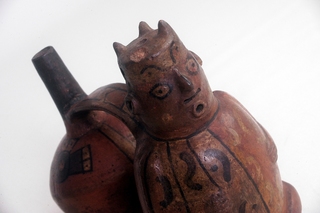Vaso Silbador
Globular flute with internal duct (421.221.41). This is the name given to the American archeological ceramic vessels which have one or two whistles and are constituted by one or several chambers. These chambers may be connected among them or not and they very frequently have a vegetal, animal or human shape. The whistles seem quite small in relation to the total size of the instrument. Their location is variable; they are found in isolation or communicated with the rest of the vessel. The whistles do not always have a duct. Most whistles vessels come from the pre-Hispanic cultures situated in Peru; they are occasionally found in Ecuador, Colombia and Mesoamerica.
Although the function of this instrument in such cultures is unknown, its ceremonial role is suspected due to the refinement of its make. The specimen at the museum comes from the Nazca culture (ca. 100-800 A.D.). Geometrical and bird-shaped drawings painted in ochre and black are widely distributed on the surface. The connection between the two chambers allows the air to pass from the blowing tube to the air duct of the whistle. This is situated inside the human head where seven soundholes have been bored. L. 18.5 x w. 9.3 x h. 14 cm. Gift, Dr. Emilio Azzarini's Collection, 1964. IM 7.







